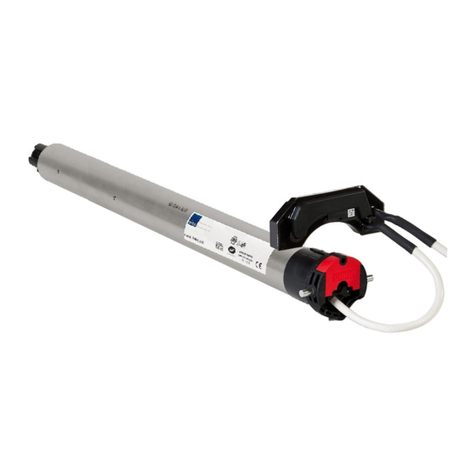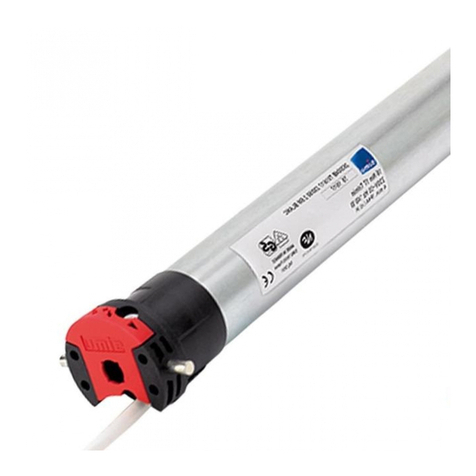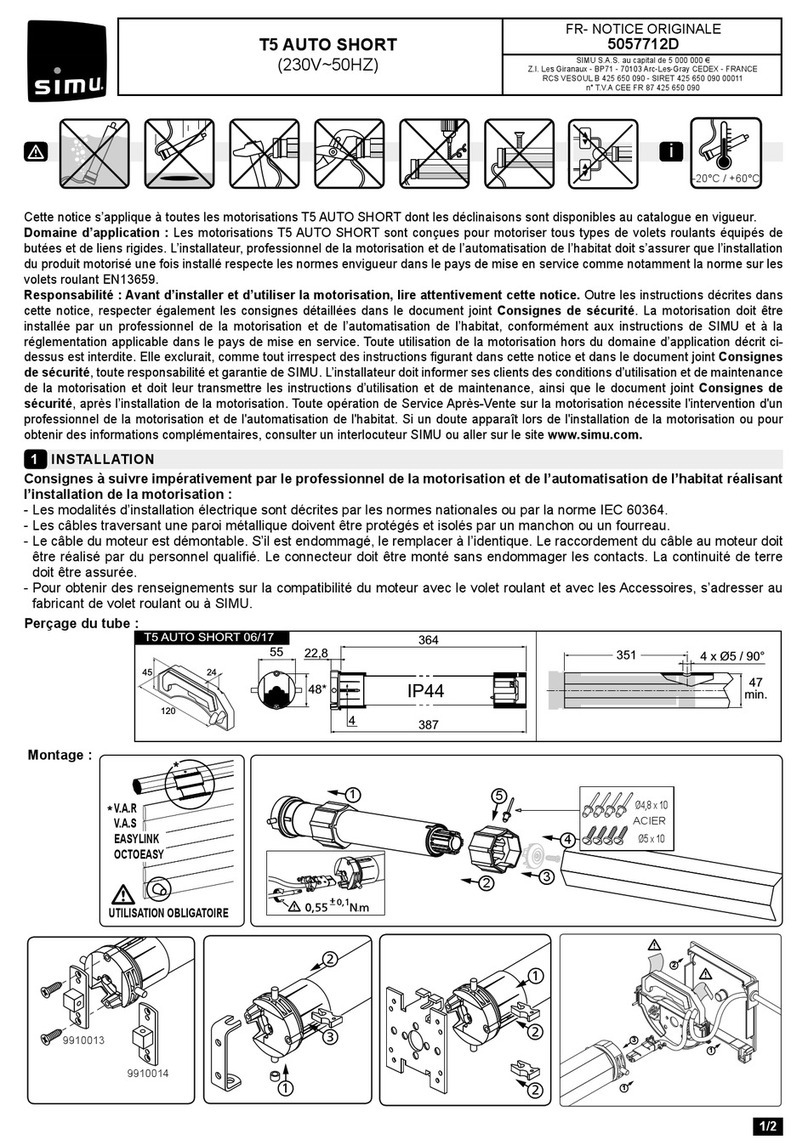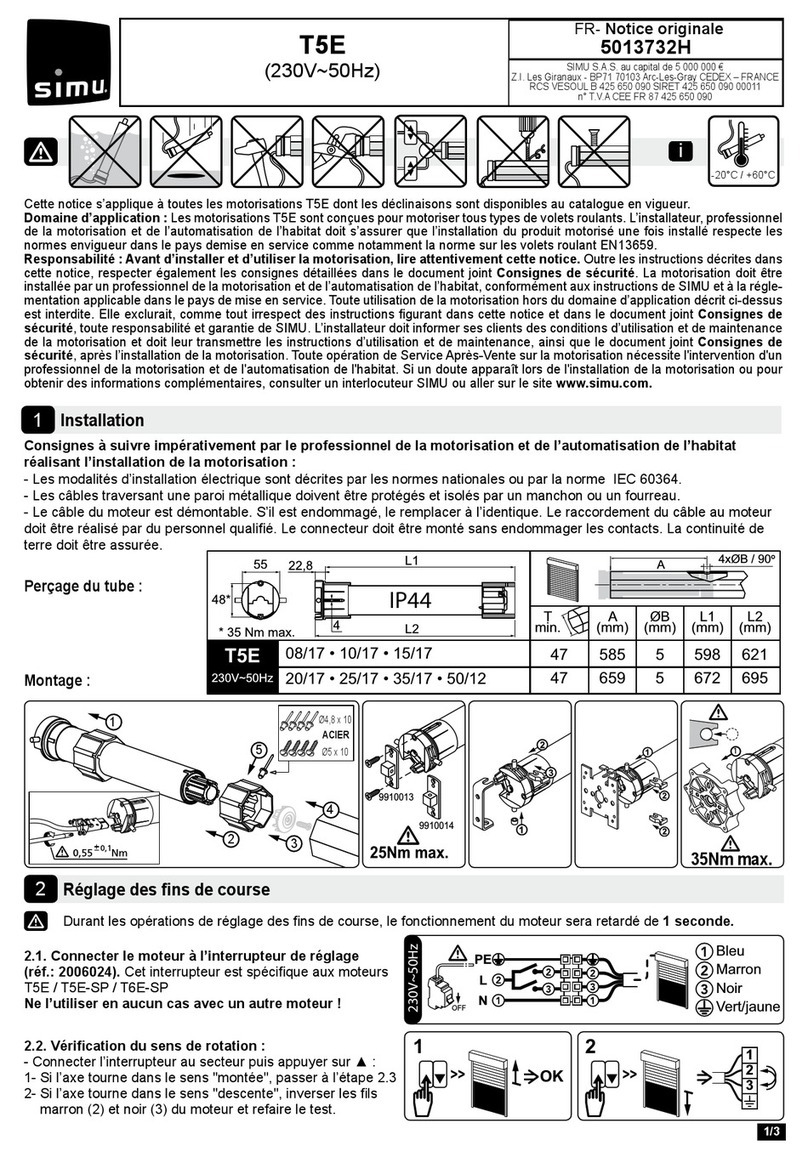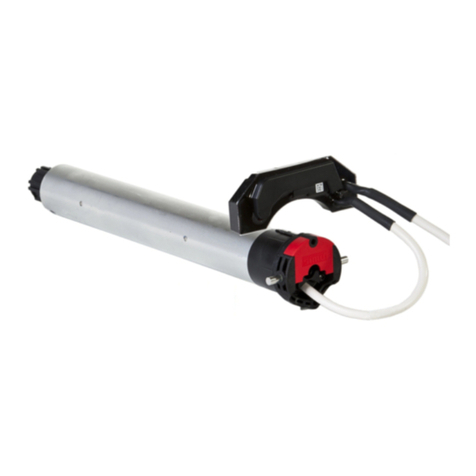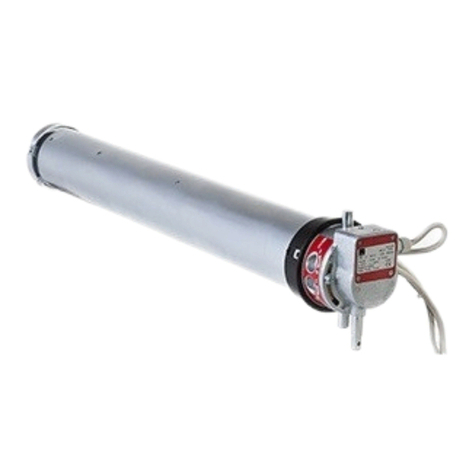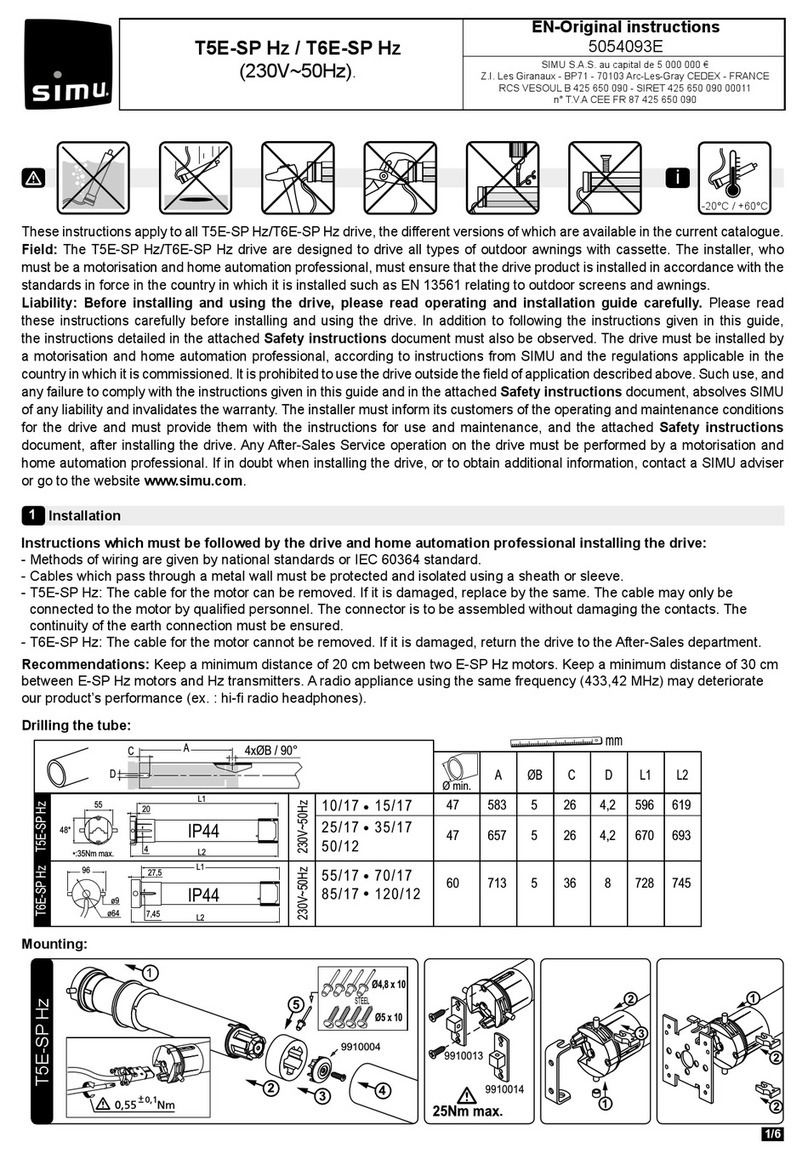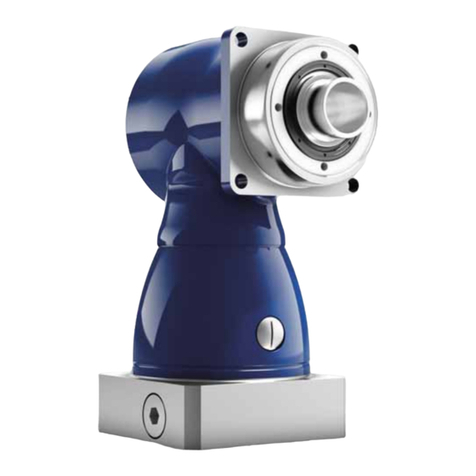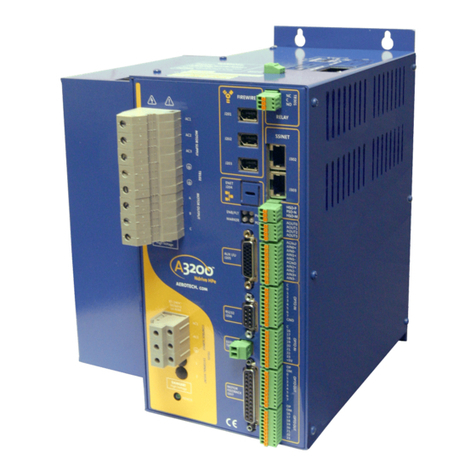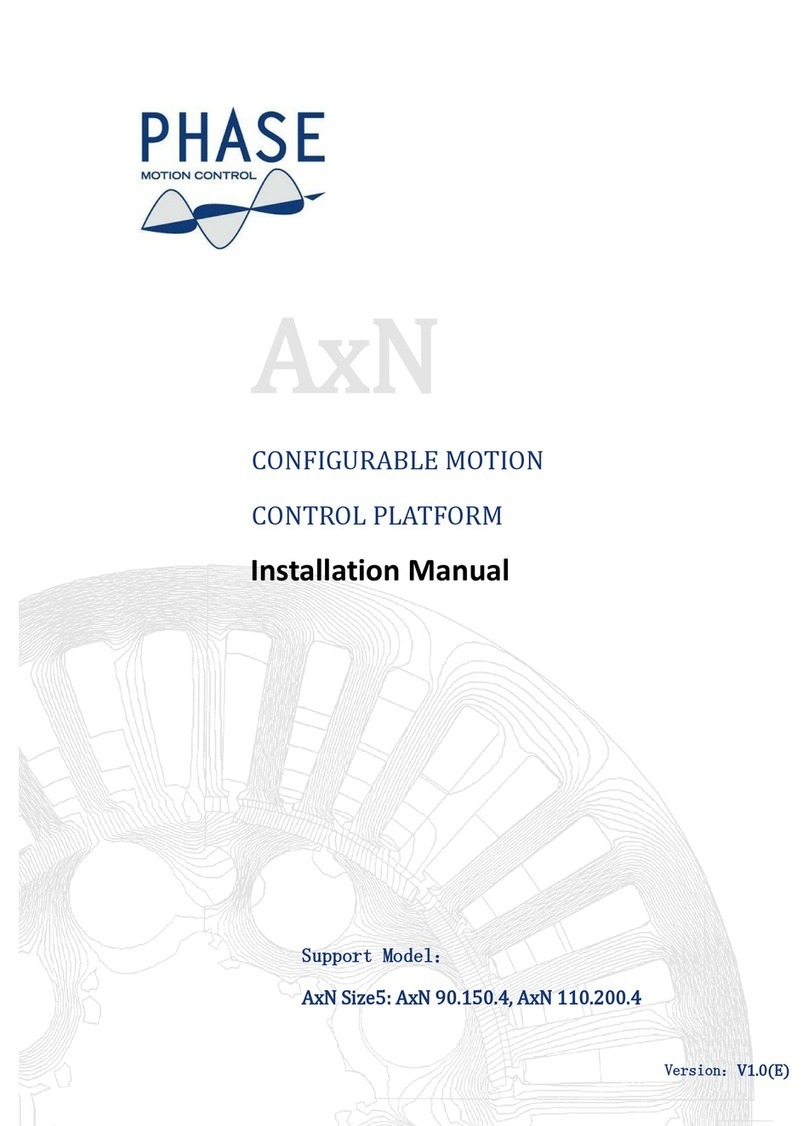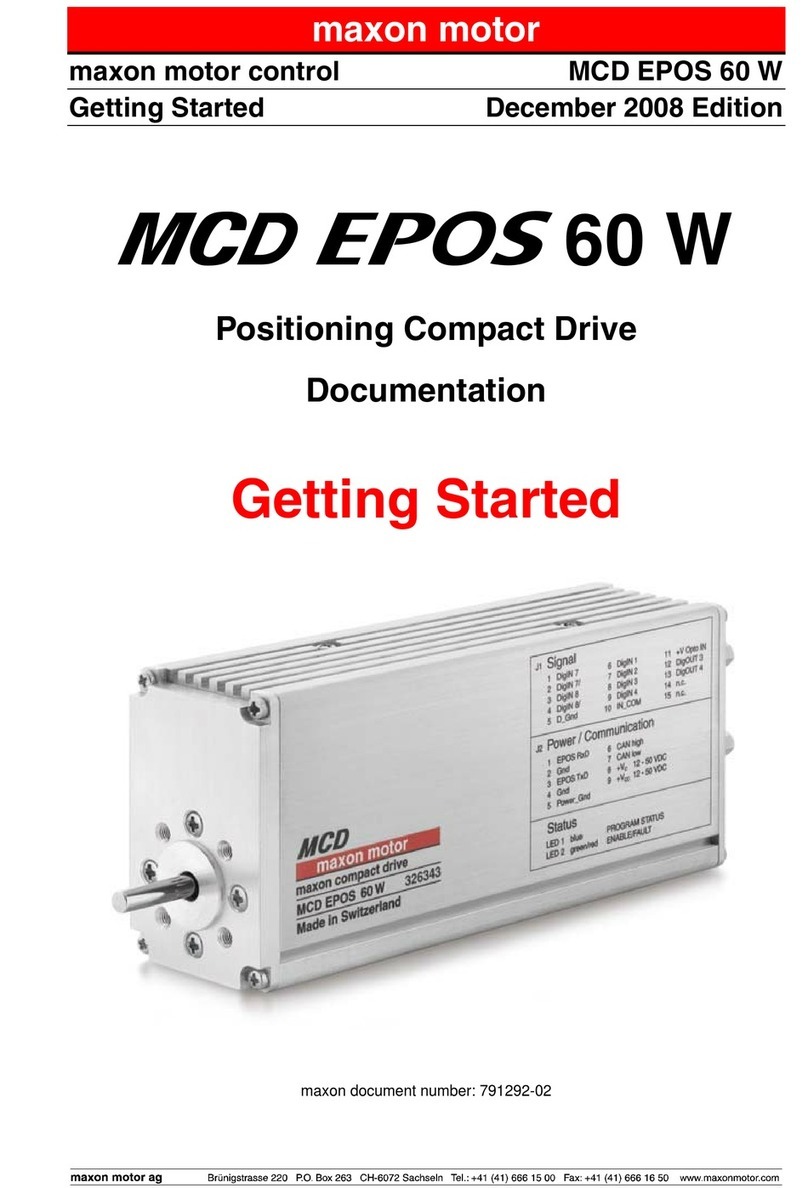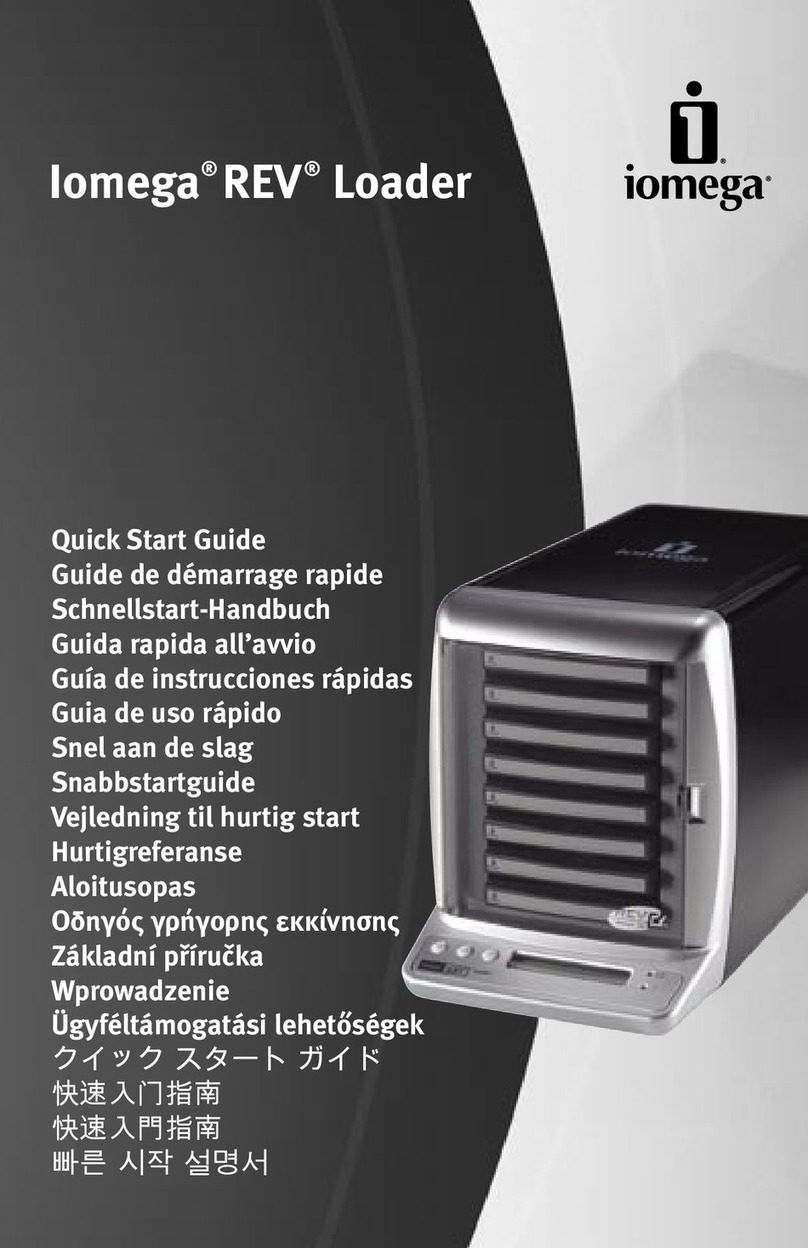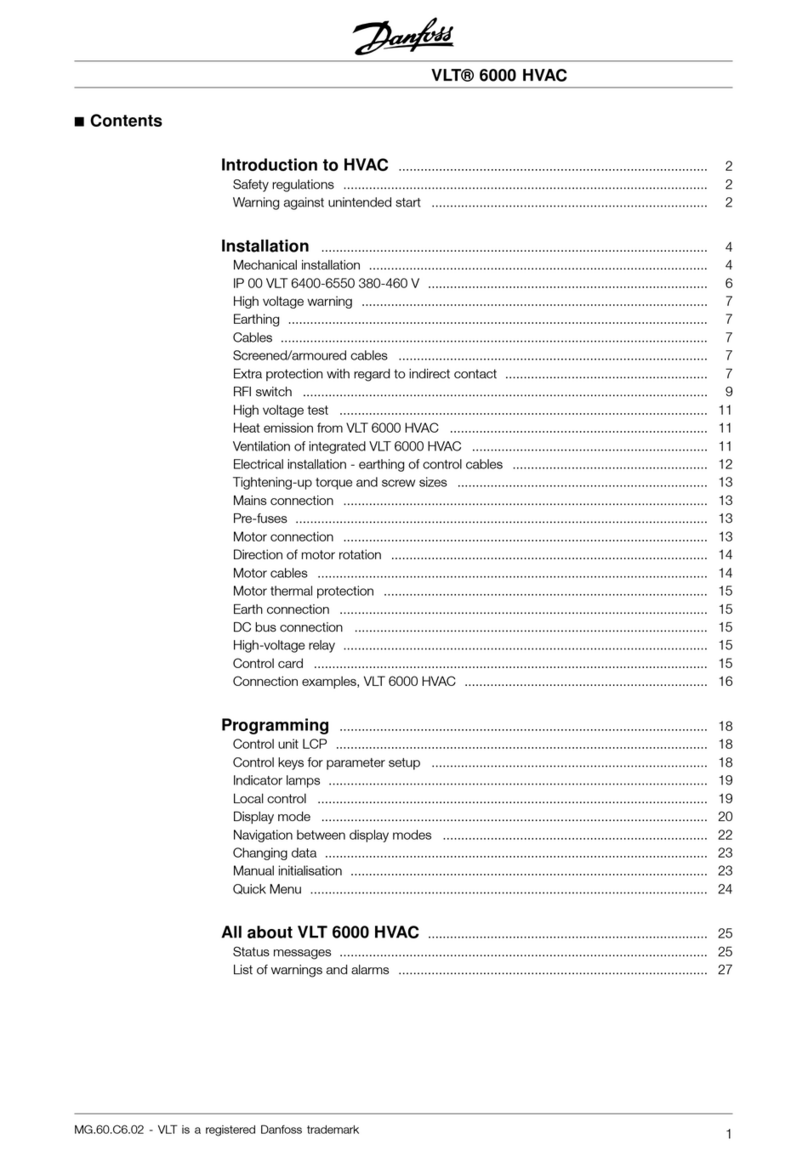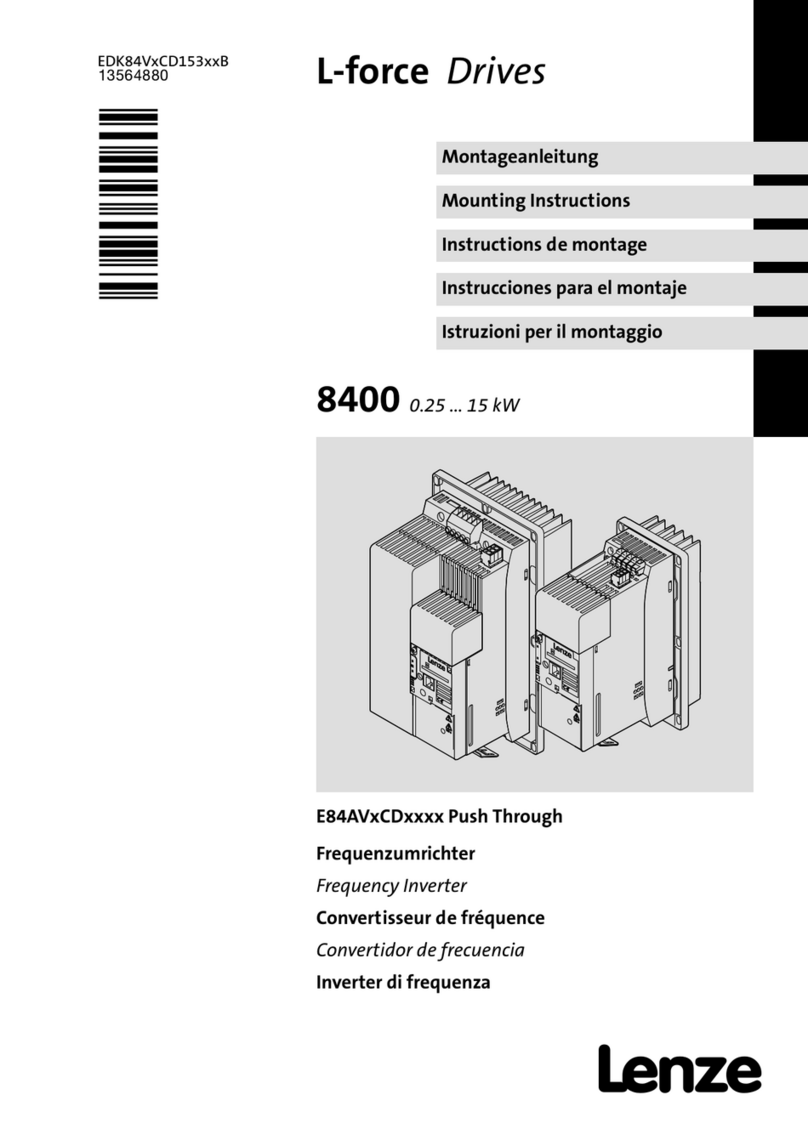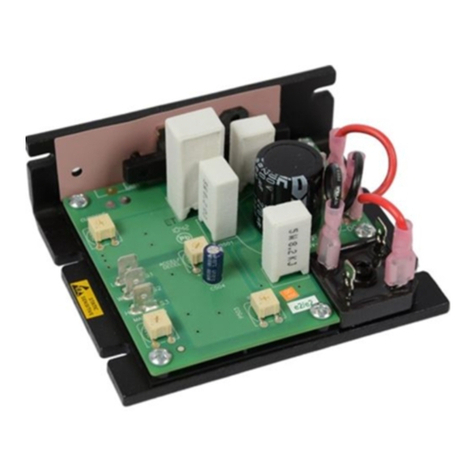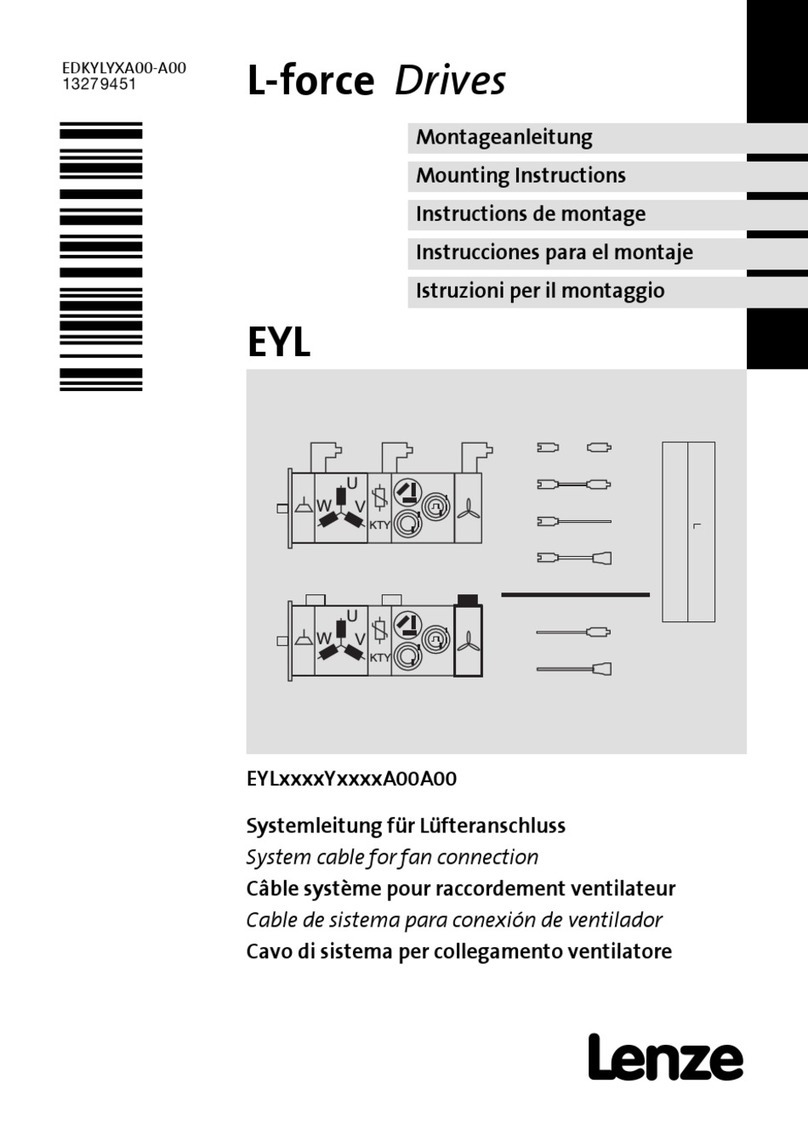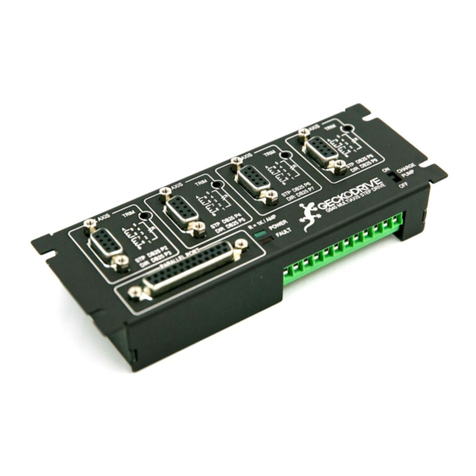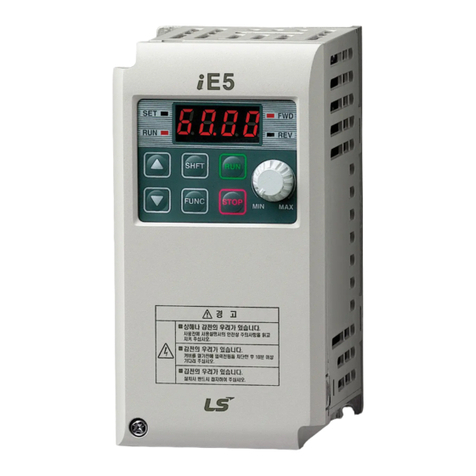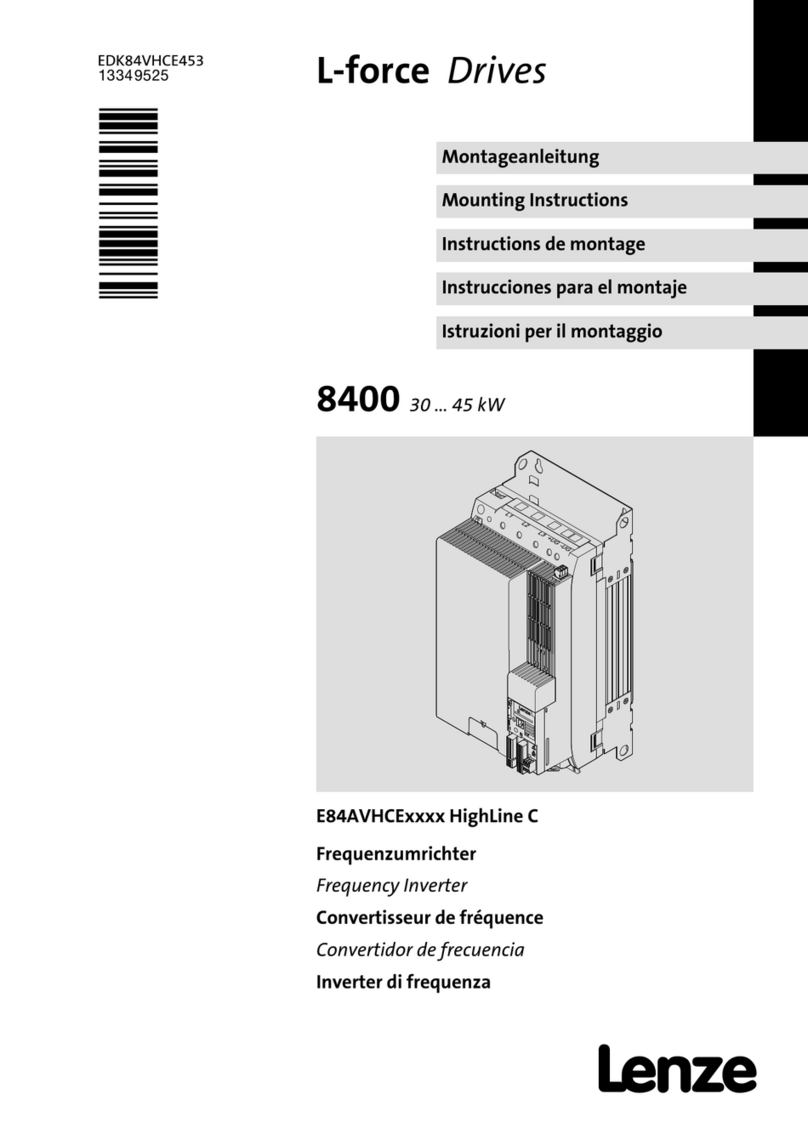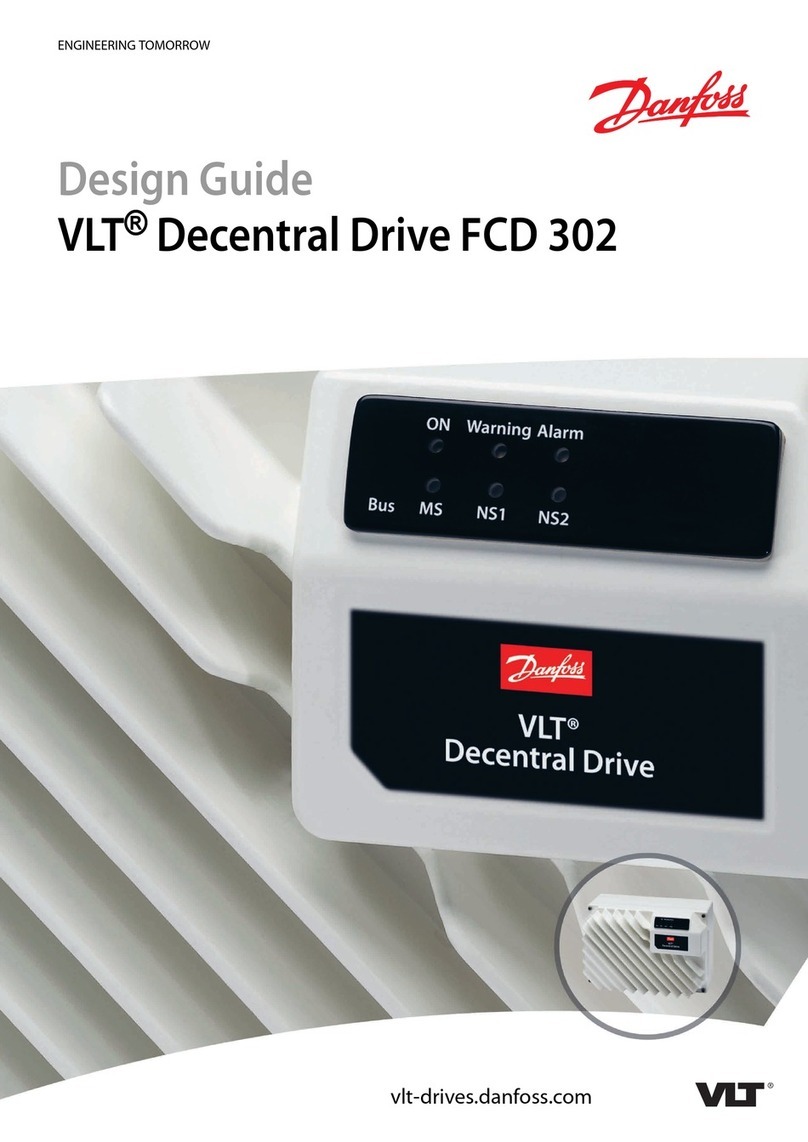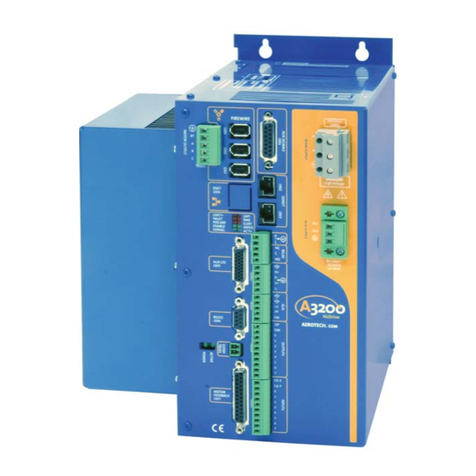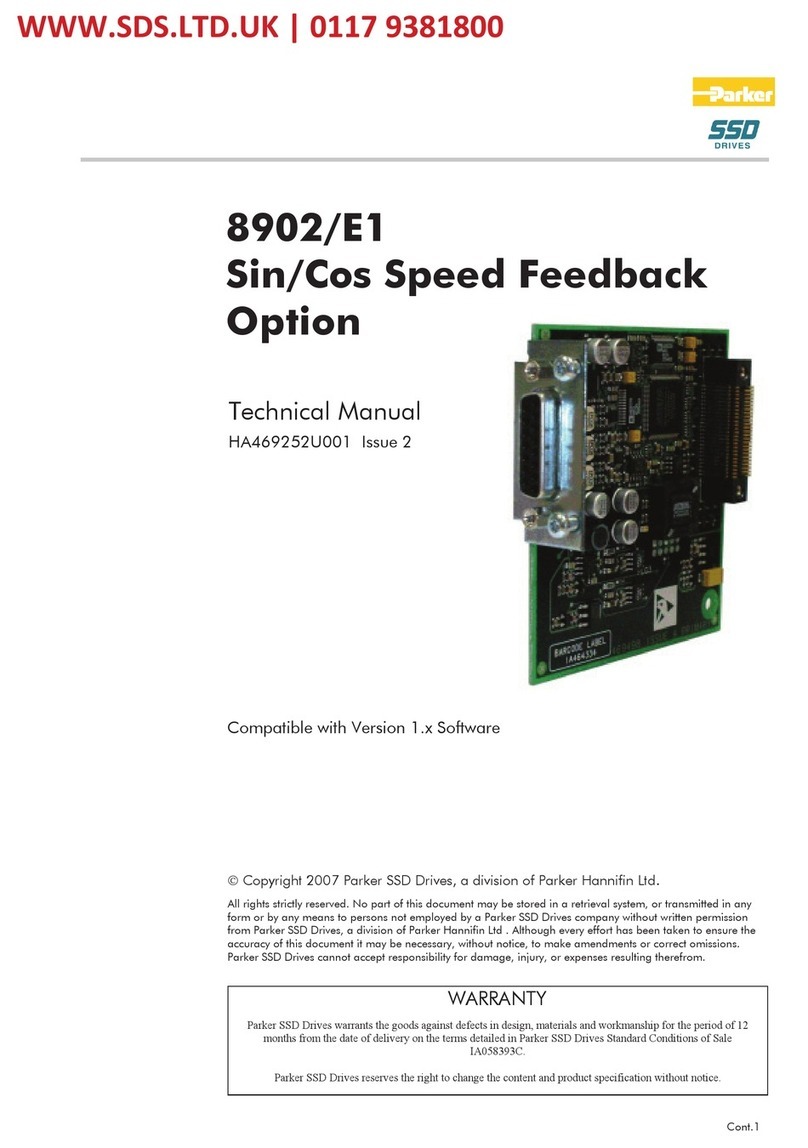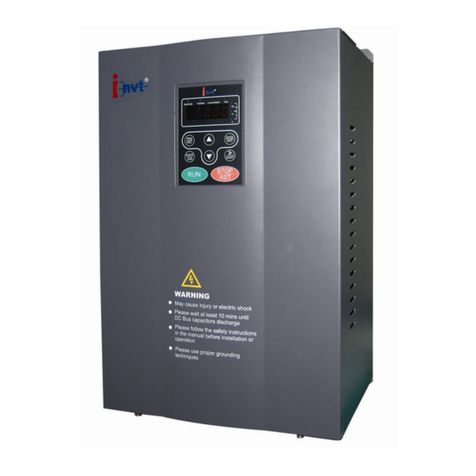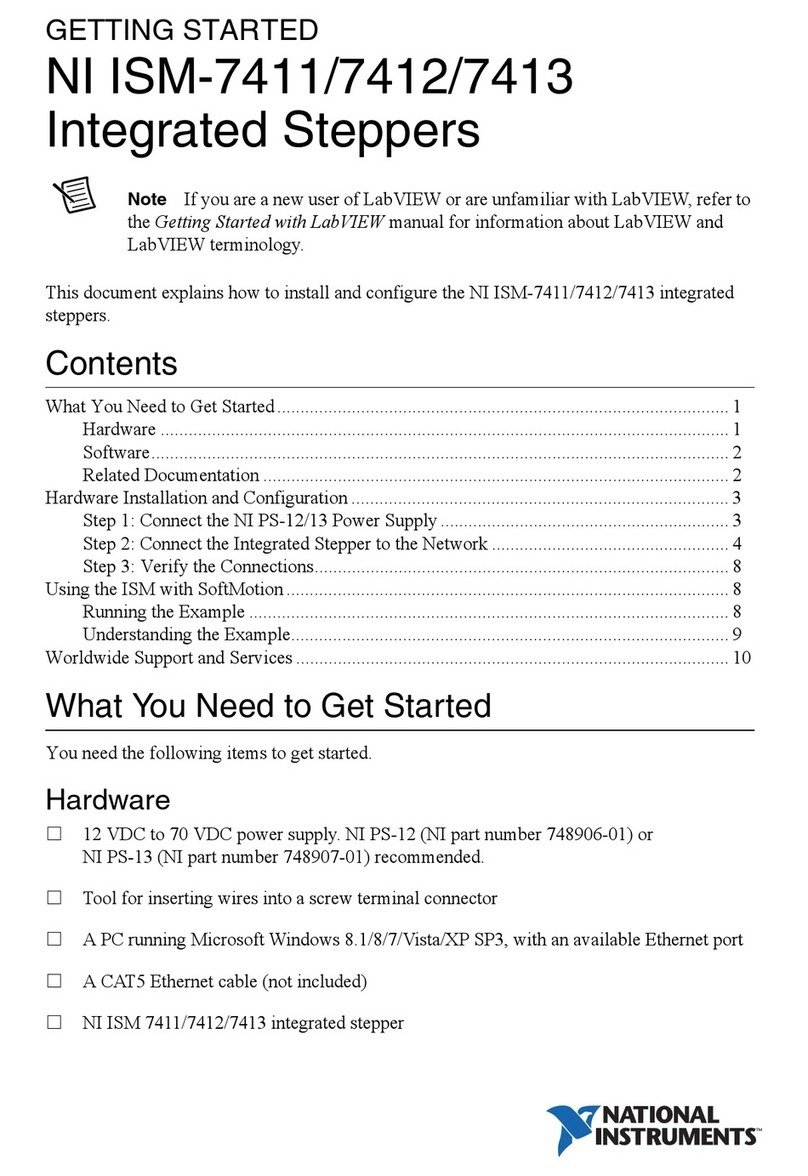Simu DMI5 Hz User manual

DMI5 Hz / DMI6 Hz
(230V~50Hz) S.A.S. au capital de 5 000 000 € - Z.I. Les Giranaux
BP71 - 70103 Arc-Les-Gray CEDEX
RCS GRAY B 425 650 090 - SIRET 425 650 090 00011
n° T.V.A CEE FR 87 425 650 090
i
-20°C / +60°C
FR- NOTICE ORIGINALE
5008554I
Installation
1
Perçage du tube :
Cette notice s’applique à toutes les motorisations DMI5 Hz/DMI6 Hz dont les déclinaisons sont disponibles au catalogue en vigueur.
Domaine d’application : Les motorisations DMI5 Hz/DMI6 Hz sont conçues pour motoriser tous types de volets roulants, de stores
d’extérieur sans cassette. L’installateur, professionnel de la motorisation et de l’automatisation de l’habitat doit s’assurer que l’installation
du produit motorisé une fois installé respecte les normes en vigueur dans le pays de mise en service comme notamment la norme sur les
volets roulants EN13659, et les stores d’extérieur EN 13561.
Responsabilité : Avant d’installer et d’utiliser la motorisation, lire attentivement cette notice. Outre les instructions décrites dans
cette notice, respecter également les consignes détaillées dans le document joint Consignes de sécurité. La motorisation doit être
installée par un professionnel de la motorisation et de l’automatisation de l’habitat, conformément aux instructions de SIMU et à la
réglementation applicable dans le pays de mise en service. Toute utilisation de la motorisation hors du domaine d’application décrit ci-
dessus est interdite. Elle exclurait, comme tout irrespect des instructions gurant dans cette notice et dans le document joint Consignes
de sécurité, toute responsabilité et garantie de SIMU. L’installateur doit informer ses clients des conditions d’utilisation et de maintenance
de la motorisation et doit leur transmettre les instructions d’utilisation et de maintenance, ainsi que le document joint Consignes de
sécurité, après l’installation de la motorisation. Toute opération de Service Après-Vente sur la motorisation nécessite l’intervention d’un
professionnel de la motorisation et de l’automatisation de l’habitat. Si un doute apparaît lors de l’installation de la motorisation ou pour
obtenir des informations complémentaires, consulter un interlocuteur SIMU ou aller sur le site www.simu.com.
Consignes à suivre impérativement par le professionnel de la motorisation et de l’automatisation de l’habitat réalisant
l’installation de la motorisation :
- Les modalités d’installation électrique sont décrites par les normes nationales ou par la norme IEC 60364.
- Les câbles traversant une paroi métallique doivent être protégés et isolés par un manchon ou un fourreau.
- Le câble du moteur n’est pas démontable. S’il est endommagé, retourner la motorisation au SAV.
Préconisations : Respecter une distance minimum de 20 cm entre deux moteurs DMI Hz. Respecter une distance minimum
de 30 cm entre un moteur DMI Hz et un émetteur Hz. L’utilisation d’un appareil radio utilisant la même fréquence (433,42MHz)
peut dégrader les performances de ce produit (ex.: casque radio Hi-Fi).
1/5
Montage :
12
43
DMI5 Hz : 9910004
DMI6 Hz : 9910062
Nm ≥ 60 & ALUMINIUM WHEEL
IP44
A
4 x ØB / 90°
4 x ØB / 90°
D
C
AØ min.
T min.
716
756
836
-
-
26 4,2
-
8
-
36
47
60
5
Ø / T min.
A B C D
10/17
35/17
•
25/17
•
50/12
60/12
100/12
•
80/12
•
120/12
DMI5 Hz
230V ~ 50Hz
DMI6 Hz
230V ~ 50Hz
Ø4,8 x 10
ACIER
7 mm
6 mm
+
4 x 90°
92
92
41,7
Ø12 x 20
4 x Ø 6,4 / Ø86

2/5
2
1
10 Nm max.
(DMI6 120 : 20Nm max.)
!
85 Nm max.
!
Câblage
2
Emetteurs compatibles
3
Réglage des ns de course
4
- Il est recommandé de pouvoir couper indi-
viduellement l’alimentation de chaque moteur.
- Attacher les câbles pour éviter tout contact avec
une partie en mouvement.
- Si la motorisation est utilisée en extérieur, et si
le câble d’alimentation est de type H05-VVF alors
installer le câble dans un conduit résistant aux UV,
par exemple sous goulotte.
PE
L
N
230V~50Hz
(12 émetteurs max. / 3 capteurs max. par moteur)
21 3
3
4
4
5
5
1 : Emetteur Hz mural 1 / 5 canaux / Memory Hz
2 : Emetteur Hz mobile 1 / 5 canaux / SUN
3 : Emetteur Hz Color Multi / Timer Easy / Timer Multi
4 : Windy Hz Accel
5 : Capteur EOSUN Hz VS
Emplacement de la touche PROG sur les émetteurs Hz :
Éloigner les émetteurs de toute surface ou structure
métallique qui pourraient nuire à leur bon fonctionnement
(perte de portée).
Si l’installation comporte plusieurs moteurs, un seul moteur doit être alimenté pendant les opérations du
chapitre 4.1, ceci pour éviter les interférences avec les autres moteurs lors de la programmation.
5s.
§4.3
§4.3
4.1- Mode apprentissage :
- Mettre le moteur sous tension.
- Appuyer simultanément sur les touches montée et descente d’un
émetteur Hz. Le moteur effectue une rotation de 0,5 seconde dans un sens
puis dans l’autre.
Cet émetteur commande maintenant le moteur en mode instable.
Passer à l’étape 4.2.
4.2- Conguration du sens de rotation :
Appuyer sur la touche «montée» de l’émetteur :
a- Si l’axe tourne dans le sens montée, passer à l’étape 4.3.
b- Si l’axe tourne dans le sens descente, inverser le sens de rotation en appuyant sur la touche stop pendant au
moins 5 secondes. Le moteur conrme la modication par une rotation de 0,5 seconde dans un sens puis dans l’autre.
Passer à l’étape 4.3.
ON
Bleu
Marron
Vert/jaune

3/5
4.3- Réglage des ns de course
4.3
- Réglage de la n de
course haute : Appuyer
sur la touche ▲ du point
de commande pour faire
monter le produit motorisé
en en n de course haute
et tourner la vis de réglage
correspondante pour ajuster
la n de course haute
souhaitée.
- Réglage de la n de
course basse : Appuyer
sur la touche ▼ du point
de commande pour faire
descendre le produit
motorisé en n de course
basse tourner la vis de
réglage correspondante
pour ajuster la n de course
basse souhaitée.
4mm
x 20 : 9000987
x 20 : 9011781

4/5
- Appuyer environ 1 seconde sur la touche PROG de l’émetteur.
Le moteur effectue une rotation de 0,5 seconde dans un sens puis
dans l’autre.
Programmation du premier point de commande individuelle
5
Cette opération ne peut être effectuée que depuis l’émetteur ayant effectué l’opération 4.1.
Votre émetteur est maintenant programmé et commande le moteur en mode stable.
PROG 1s.
1
PROG ≤1s.
2
PROG ≤1s.
2
PROG ≥3s.
1
PROG ≥3s.
1
6.2- Valider l’opération depuis le nouvel émetteur à
programmer :
- Appuyer environ 1 seconde sur la touche PROG du nouvel
émetteur. Le moteur effectue une rotation de 0,5 seconde dans un
sens puis dans l’autre.
6.1- Ouvrir la mémoire du moteur depuis l’émetteur
de commande individuelle :
- Appuyer environ 3 secondes sur la touche PROG de l’émetteur
de commande individuelle. Le moteur effectue une rotation de 0,5
seconde dans un sens puis dans l’autre.
Programmation d’un nouveau point de commande (individuelle, groupe ou générale)
6
- Si votre nouveau point de commande est une commande de groupe : répéter les opérations 6.1 et 6.2 pour chaque moteur du groupe.
- Si votre nouveau point de commande est une commande générale : répéter les opérations 6.1 et 6.2 pour chaque moteur de l’installation.
- Pour supprimer un émetteur de la mémoire du moteur : effectuer les opérations 6.1 depuis l’émetteur de commande
individuelle et l’opération 6.2 depuis l’émetteur à supprimer.
Programmation d’un automatisme
7
7.1- Ouvrir la mémoire du moteur depuis l’émetteur de
commande individuelle :
- Appuyer environ 3 secondes sur la touche “PROG” de l’émetteur
de commande individuelle. Le moteur effectue une rotation de 0,5
seconde dans un sens puis dans l’autre.
7.2- Valider l’opération depuis l’automatisme
à programmer :
- Appuyer environ 1 seconde sur la touche “PROG” de l’automatisme.
Le moteur effectue une rotation de 0,5s dans un sens puis dans l’autre.
- Si votre automatisme doit contrôler un groupe de moteur : répéter les opérations 7.1 et 7.2 pour chaque moteur du groupe.
- Pour supprimer l’automatisme de la mémoire du moteur : effectuer l’opération 7.1 depuis l’émetteur de commande
individuelle et l’opération 7.2 depuis l’automatisme à supprimer.
Préconisations concernant l’emploi d’un automatisme : En cas d’échange ou de suppression de l’automatisme,
il est impératif de le supprimer de la mémoire de tous les moteurs dans lesquels il était programmé.
Si vous souhaitez programmer un autre émetteur que celui utilisé jusqu’à présent comme point de commande
du moteur :
- couper l’alimentation du moteur (2 secondes minimum).
- reprendre l’opération 4.1 avec un nouvel émetteur avant de passer au chapitre 5.

5/5
9.1- Couper l’alimentation du moteur pendant 2 secondes.
9.2- Rétablir l’alimentation du moteur pendant 7 secondes.
9.3- Couper l’alimentation du moteur pendant 2 secondes.
9.4- Rétablir l’alimentation du moteur. Le moteur va tourner dans un
sens quelconque pendant 5 secondes.
Vous êtes en mode «annulation de la programmation».
- Appuyer plus de 7 secondes sur la touche PROG de
l’émetteur. Le moteur effectue une rotation de 0,5 seconde
dans un sens puis dans l’autre.
Annulation de la programmation
9
9.5- Ensuite valider l’annulation de la programmation du moteur concerné depuis l’émetteur de
commande individuelle :
Utilisation et maintenance
10
- Cette motorisation ne nécessite pas d’opération de maintenance.
- Appuyer sur la touche ▲du point de commande pour faire monter le produit motorisé.
- Appuyer sur la touche ▼ du point de commande pour faire descendre le produit motorisé.
- Quand le produit motorisé est en cours de mouvement, faire un appui bref sur Stop.
Le produit motorisé s’arrête automatiquement.
Astuces et conseils d’utilisation :
Si le produit motorisé ne fonctionne toujours pas, contacter un professionnel de la motorisation et de l’automatisation de
l’habitat.
Par la présente, SIMU SAS, F-70103 GRAY déclare en tant que fabricant que la motorisation couverte par ces instructions, marquée pour
être alimentée en 230V~50Hz et utilisée comme indiqué dans ces instructions, est conforme aux exigences essentielles des Directives
Européennes applicables et en particulier de la Directive Machine 2006/42/EC et de la Directive Radio 2014/53/EU. Le texte complet de la
déclaration de conformité à l’UE est disponible sur www.simu.com. Emmanuel CARMIER, directeur général, GRAY, 11/2016
CONSTATS
Le produit motorisé ne fonctionne pas
CAUSES POSSIBLES
La motorisation est en protection thermique
SOLUTIONS
Attendre que le moteur refroidisse
OFF
2s. 7s. 2s.
5s.
ON ONOFF
Si vous intervenez sur l’alimentation de plusieurs moteurs, ils seront tous dans ce mode. Il convient donc
«d’éjecter» de ce mode tous les moteurs non concernés par cette modication en appuyant sur une touche de
commande d’un émetteur programmé.
PROG > 7s.
1
La mémoire du moteur est maintenant complètement vidée. Effectuer de nouveau la programmation complète du moteur.

DMI5 Hz / DMI6 Hz
(230V~50Hz) S.A.S. au capital de 5 000 000 € - Z.I. Les Giranaux
BP71 - 70103 Arc-Les-Gray CEDEX
RCS GRAY B 425 650 090 - SIRET 425 650 090 00011
n° T.V.A CEE FR 87 425 650 090
i
-20°C / +60°C
EN- ORIGINAL INSTRUCTIONS
5008554I
1/5
Installation
1
Drilling the tube:
These instructions apply to all DMI5 Hz/DMI6 Hz drive, the different versions of which are available in the current catalogue.
Field of application: DMI5 Hz/DMI6 Hz drive are designed to drive all types of roller shutters, outdoor awnings without cassette. The
installer, who must be a motorisation and home automation professional, must ensure that the drive product is installed in accordance with
the standards in force in the country in which it is installed such as EN 13659 relating to roller shutters, and EN13561 relating to outdoor
screens and awnings.
Liability: Before installing and using the drive, please read operating and installation guide carefully. Please read these instruc-
tions carefully before installing and using the drive. In addition to following the instructions given in this guide, the instructions detailed in
the attached Safety instructions document must also be observed. The drive must be installed by a motorisation and home automation
professional, according to instructions from SIMU and the regulations applicable in the country in which it is commissioned. It is prohibited
to use the drive outside the eld of application described above. Such use, and any failure to comply with the instructions given in this
guide and in the attached Safety instructions document, absolves SIMU of any liability and invalidates the warranty. The installer must
inform its customers of the operating and maintenance conditions for the drive and must provide them with the instructions for use and
maintenance, and the attached Safety instructions document, after installing the drive. Any After-Sales Service operation on the drive
must be performed by a motorisation and home automation professional. If in doubt when installing the drive, or to obtain additional infor-
mation, contact a SIMU adviser or go to the website www.simu.com.
Instructions which must be followed by the drive and home automation professional installing the drive:
- Methods of wiring are given by national standards or IEC 60364 standard.
- Cables which pass through a metal wall must be protected and isolated using a sheath or sleeve.
- The cable for the motor cannot be removed. If it is damaged, return the drive to the After-Sales department.
Recommendations: Keep a minimum distance of 20 cm between two DMI Hz motors. Keep a minimum distance of 30 cm
between DMI Hz motors and Hz transmitters. A radio appliance using the same frequency (433,42 MHz) may deteriorate our
product’s performance (ex.: hi- radio headphones).
Mounting:
12
43
DMI5 Hz : 9910004
DMI6 Hz : 9910062
Nm ≥ 60 & ALUMINIUM WHEEL
IP44
A
4 x ØB / 90°
4 x ØB / 90°
D
C
AØ min.
T min.
716
756
836
-
-
26 4,2
-
8
-
36
47
60
5
Ø / T min.
A B C D
10/17
35/17
•
25/17
•
50/12
60/12
100/12
•
80/12
•
120/12
DMI5 Hz
230V ~ 50Hz
DMI6 Hz
230V ~ 50Hz
Ø4,8 x 10
STEEL
7 mm
6 mm
+
4 x 90°
92
92
41,7
Ø12 x 20
4 x Ø 6,4 / Ø86

2/5
2
1
10 Nm max.
(DMI6 120 : 20Nm max.)
!
85 Nm max.
!
Wiring
2
Compatible transmitters
3
End limit adjustement
4
- You must have the possibility to switch off
individually each motor.
- Attach cables to prevent any contact with moving
parts.
- If the motor is used outdoors and if the power
supply cable is of the H05-VVF type, then run the
cable in a UV-resistant conduit, e.g. trunking.
PE
L
N
230V~50Hz
(12 transmitters max./3 sensors max. for one motor)
21 3
3
4
4
5
5
1 : 1/5 channels Wall Hz transmitter / Memory Hz
2 : 1/5 channels / SUN Mobile Hz transmitter
3 : Color Multi 16 / Timer Easy / Timer Multi transmitters
4 : Windy Hz Accel
5 : EOSUN Hz VS
Location of the PROG key on Hz transmitters:
Do not position the transmitter near metal in order to
avoid range losses.
If the installation includes several motors, only one motor is to be powered during this programming procedure
(4,1). It will eliminate interferences with the other motor during the procedure.
5s.
§4.3
§4.3
4.1-Learning mode:
- Switch the motor ON.
- Simultaneously press the UP and DOWN keys of a Hz transmitter. The
motor will run for 0,5 second in one direction, then in the other. The transmitter
now controls the motor in unstable mode, move to stage 4.2
4.2- Checking the rotation direction:
Press the UP key of the transmitter:
a- If the motorized tube runs in the UP direction, move to next stage (4.3).
b- If the motorized tube runs in the DOWN direction, reverse the rotation direction by pressing the Stop key for at least 5
seconds. The motor will run for 0,5 second in one direction, then in the other direction. Move to the stage 4.3.
ON
Blue
Brown
Green / yellow

3/5
4.3- End limit adjustement:
4.3
- Setting the upper end
limit: Press the ▲ button
on the control point to raise
the motorised product to the
upper end limit and turn the
corresponding setting screw
to set the required upper
end limit.
- Setting the lower end
limit: Press the ▼ button
on the control point to lower
the motorised product to the
lower end limit and turn the
corresponding setting screw
to set the required lower
end limit.
4mm
x 20 : 9000987
x 20 : 9011781

4/5
- Press the transmitter PROG Key for approximately one second.
The motor will run for 0,5 second in one direction and then in the other.
Programming the rst individual control point
5
This operation can only be performed from the transmitter that was used for operation 4.1.
Your transmitter is now programmed to control the motor in stable mode.
PROG 1s.
1
PROG ≤1s.
2
PROG ≤1s.
2
PROG ≥3s.
1
PROG ≥3s.
1
6.2- Conrm the operation from the new transmitter
you want to program:
- Press the PROG key of the transmitter for 1 second. The motor
will run for 0,5 second in one direction and then in the other.
6.1- Open the memory of the receiver from the control
transmitter:
- Press the PROG key of the transmitter for about 3 seconds. The
motor will run for 0,5 second in one direction and then in the other.
Programming a new (individual, group or general) control point
6
- For group controls, repeat operations 6.1 and 6.2 for each motor in the group.
- For general controls, repeat operations 6.1 and 6.2 for each motor in the installation.
- To delete an transmitter from the memory of a motor, perform operations 6.1 with a programmed transmitter, then perform
the operation 6.2 with the transmitter to be deleted.
Programming a sensor
7
7.1- Open the memory of the motor from the individual
control transmitter:
- Press the PROG key of the transmitter for about 3 seconds until the
motor jogs in both directions.
7.2- Conrm the operation from the sensor you wish to
add:
- Press the PROG key of the sensor less than 1 second. The motor
will jog in both directions.
- For group controls, repeat operations 7,1 and 7,2 for each motor in the group.
- To delete a sensor from the motor’s memory: Perform operation 7.1 from the individual control transmitter and operation 7.2
from the automatic control to be deleted.
Recommendations when using a sensor: If the Wind sensor on an installation is changed or deleted, it is important to
delete it from the memory of all the motors in which it was programmed: perform operations a with a programmed transmitter,
then perform the operation b with the sensor to be deleted.
If you do not want to use this transmitter as the individual control:
- cut the power supply (2 seconds minimum).
- repeat the opération 4.1* with a new transmitter and then go to step §5.

5/5
If the motorised product still does not work, contact a drive and home automation professional.
9.1 - Switch off the power supply to the motor for 2 seconds.
9.2 - Switch the power to the motor back on for 7 seconds.
9.3 - Switch off the power supply to the motor for 2 seconds.
9.4 - Switch the power to the motor back on. The motor will run for 5
seconds in random direction.
The motor is now in the “cancelling” mode
- Press the PROG key of the transmitter more than
7 seconds. Maintain the pressure until the motor will rst
run for 0,5 second in one direction and then in the other.
Cancelling programming
9
9.5 - Then, conrm the cancelling of the concerned motor from the individual control:
Operation and maintenance
10
- This drive is maintenance-free.
- Press the ▲ button on the control point to lower the motorised product.
- Press the ▼ button on the control point to raise the motorised product.
- If the motorised product is moving, briey press the Stop button. The motorised product stops automatically.
Tips and recommendations for use:
SIMU SAS, F-70103 as manufacturer hereby declares that the drive covered by these instructions when marked for input voltage 230V~50Hz
and used as intended according to these instructions, is in compliance with the essential requirements of the applicable European Directives
and in particular of the Machinery Directive 2006/42/EC, and the Radio Directive 2014/53/EU. The full text of the EU declaration of conformity
is available at www.simu.com. Emmanuel CARMIER, general director, GRAY, 11/2016.
OBSERVATIONS
The driven product does not operate.
POSSIBLE CAUSES
The drive’s overheating protection on the
drive has tripped.
SOLUTIONS
Wait for the drive to cool down.
OFF
2s. 7s. 2s.
5s.
ON ONOFF
If you switch off the power to several motors, they will all be in cancelling mode. That is why, you must “eject” out
of this mode all the receivers that are not to be deleted by sending a command from their individual control transmitter
(UP or Down).
PROG > 7s.
1
The motor is now as it was originally congured, and no transmitter and no settings is saved in its memory and is ready for a
new programming.

1/5
DMI5 Hz / DMI6 Hz
(230V~50Hz) S.A.S. au capital de 5 000 000 € - Z.I. Les Giranaux
BP71 - 70103 Arc-Les-Gray CEDEX
RCS GRAY B 425 650 090 - SIRET 425 650 090 00011
n° T.V.A CEE FR 87 425 650 090
DE- ORIGINALANLEITUNG
5008554I
Installation
1
Bohrungen im Rollladenwelle:
Diese Anleitung gilt für alle Antriebe vom Typ DMI5 Hz/DMI6 Hz deren Ausführungen im aktuellen Katalog zu nden sind.
Bestimmungsgemäße Verwendung: Die Antriebe DMI5 Hz/DMI6 Hz wurden für den Antrieb aller Arten von Rollläden, von Außenmarkisen
ohne Kassette. Der Installateur, ein Fachmann für Gebäudeautomation, muss sicherstellen, dass die Installation des Antriebs nach Montage
den geltenden Vorschriften des Orts der Inbetriebnahme entspricht. Hierzu gehören insbesondere die Norm(en): EN13659 (Rollläden), und EN
13561 (Außenjalousien).
Haftung: Lesen Sie bitte vor der Montage und Verwendung des Antriebs diese Installationsanleitung sorgfältig durch. Beachten Sie
außer den Anweisungen in dieser Anleitung auch die detaillierten Hinweise im beiliegenden Dokument «Sicherheitshinweise». Die Installation
des Antriebs muss von einem Fachmann für Gebäudeautomation unter Einhaltung der Anweisungen von SIMU und der am Ort der Inbetrieb-
nahme geltenden Vorschriften ausgeführt werden. Jede Nutzung des Antriebs zu Zwecken, die über den im vorliegenden Dokument beschrie-
benen Anwendungsbereich hinausgehen, ist untersagt. Jede Missachtung dieser sowie aller anderen in dieser Anleitung und im beiliegenden
Dokument «Sicherheitshinweise» enthaltenen Anweisungen führt zum Ausschluss jeglicher Haftung und Gewährleistungsansprüche durch
SIMU. Der Installateur hat seine Kunden auf die Nutzungsund Wartungsbedingungen des Antriebs hinzuweisen und ihnen diese sowie das
beiliegende Dokument «Sicherheitshinweise» nach Abschluss der Installation des Antriebs auszuhändigen. Wartungs- und Reparaturarbeiten
für den Antrieb dürfen ausschließlich von Fachleuten für Gebäudeautomation ausgeführt werden. Für Fragen zur Installation des Antriebs
und weiterführende Informationen wenden Sie sich bitte an Ihren SIMU-Ansprechpartner oder besuchen Sie unsere Website www.simu.com.
Hinweise, die die installierende Fachkraft zu beachten hat:
- Die Verdrahtung muss internationalem oder dem IEC60364 Standard entsprechen.
- Alle Kabel, die in Kontakt mit einer metallischen Wandung geraten könnten, müssen mit einer Hülse oder Ummantelung
geschützt und isoliert werden.
- Das Kabel des Antriebes kann nicht demontiert werden. Wenn es beschädigt ist, müssen Sie den Antrieb zum Kundendienst
bringen.
Empfehlungen: Halten Sie eine Mindestdistanz von 20 cm zwischen zwei DMI Hz Motoren ein. Halten Sie eine Mindestdistanz
von 30 cm zwischen DMI Hz Motoren und Hz- Funksendern ein. Ein Radiogerät, das die gleiche Frequenz nutzt (433,42 MHz),
könnte die Leistung des Produkts stören (z.B. Hi-Fi Radio-Kopfhörer).
Montage:
12
43
DMI5 Hz : 9910004
DMI6 Hz : 9910062
Nm ≥ 60 & ALUMINIUM WHEEL
IP44
A
4 x ØB / 90°
4 x ØB / 90°
D
C
AØ min.
T min.
716
756
836
-
-
26 4,2
-
8
-
36
47
60
5
Ø / T min.
A B C D
10/17
35/17
•
25/17
•
50/12
60/12
100/12
•
80/12
•
120/12
DMI5 Hz
230V ~ 50Hz
DMI6 Hz
230V ~ 50Hz
Ø4,8 x 10
STAHL
7 mm
6 mm
+
4 x 90°
92
92
41,7
Ø12 x 20
4 x Ø 6,4 / Ø86
i
-20°C / +60°C

2/5
2
1
10 Nm max.
(DMI6 120 : 20Nm max.)
!
85 Nm max.
!
Schaltplan
2
Kompatible Sender
3
Einstellung der Endlagen
4
- Wir empfehlen, für jeden Motor eine
separate Abschaltung zu verwenden.
- Bringen Sie die Kabel so an, dass sie nicht Kontakt
zu beweglichen Teilen geraten können.
- Wenn der Antrieb im Freien montiert wird und mit
einem Netzkabel vom Typ H05-VVF versehen ist,
ist das vor Netzkabel UV-Strahlen zu schützen, z.B.
durch ein Schutzrohr.
PE
L
N
230V~50Hz
(Maximal 12 Sender pro Motor/3 Sensor pro Motor)
21 3
3
4
4
5
5
1 : 1/5 Kanal Hz Wandsender/ Memory Hz
2 : 1/5 Kanal / SUN Hz Handsender
3 : Color Mult /Timer Easy/Timer Multi Handsender
4 : Windy Hz Accel
5 : EOSUN Hz VS
Anordnung der PROG Taste am Hz-Sender:
Bewahren Sie den Sender nicht in der Nähe metallischer
Objekte auf, diese könnten die Senderleistung
beeinussen (geringere Reichweite).
Wenn die Installation mehrere Motoren umfasst, darf während der Programmierung nur ein Motor mit Strom
versorgt werden. Auf diese Weise werden Störungen durch andere Motoren während der Programmierung
vermieden.
5s.
§4.3
§4.3
4.1- Programmiermodus:
- Schalten Sie den Motor EIN.
- Drücken Sie gleichzeitig die AUF- und AB-Taste eines Hz Senders. Der Motor
läuft 0,5 Sekunde in die eine, dann in die andere Richtung. Der Sender steuert
nun den Motor im Totmannbetrieb. Siehe Schritt 4.2
4.2- Überprüfen der Laufrichtung:
Drücken Sie die OBEN-Taste am Sender:
a- Wenn sich das Rollladenelement mit Motor nach oben bewegt, wechseln Sie zum nächsten Schritt 4.3.
b- Wenn sich das Rollladenelement mit Motor nach unten bewegt, ändern Sie die Richtung, indem Sie die STOPP Taste
mindestens 5 S. lang gedrückt halten. Der Empfänger bestätigt den Richtungswechsel und dreht 0,5 S. lang in die eine,
dann in die andere Richtung. Weiter mit Schritt 4.3
ON
Blau
Braun
Grün / Gelb

3/5
4.3 - Einstellung der Endlagen:
4.3
- Einstellung der oberen
Endlage: Drücken Sie
an der Bedieneinheit die
Taste ▲, um den Behang
in seine obere Endlage
zu bringen, und drehen
Sie die betreffende
Einstellschraube, um die
gewünschte obere Endlage
zu justieren.
- Einstellung der unteren
Endlage: Drücken Sie
an der Bedieneinheit die
Taste ▼, um den Behang
in seine untere Endlage
zu bringen, und drehen
Sie die betreffende
Einstellschraube, um die
gewünschte untere Endlage
zu justieren.
4mm
x 20 : 9000987
x 20 : 9011781

4/5
- Halten Sie die Taste PROG ca. 1 Sekunde lang gedrückt.
Der Motor läuft 0,5 Sekunde in die eine, dann in die andere
Richtung.
Programmierung des ersten individuellen Steuerpunkts
5
Diese Einstellung kann nur für den unter Punkt 4.1 verwendeten Sender vorgenommen werden.
Ihr Sender ist nun so programmiert, dass er den Motor zuverlässig steuert.
PROG 1s.
1
PROG ≤1s.
2
PROG ≤1s.
2
PROG ≥3s.
1
PROG ≥3s.
1
6.2- Bestätigen Sie die Eingaben an dem neu zu
programmierenden Sender :
- Halten Sie die Taste PROG des Senders ca. 1 Sekunde lang
gedrückt. Der Motor läuft 0,5 Sekunde in die eine, dann in die
andere Richtung.
6.1- Öffnen Sie den Speicher des Motors mit einem
Einzelsteuersender:
- Halten Sie die Taste PROG des Senders ca. 3 Sekunden lang
gedrückt. Der Motor läuft 0,5 Sekunde in die eine, dann in die
andere Richtung.
Programmierung eines neuen (individuellen, Gruppen- oder Haupt-) Steuerpunkts
6
- Für Gruppensteuerungen wiederholen Sie die Schritte 6,1 und 6.2 für jeden Empfänger der Gruppe.
- Für die Hauptsteuerung wiederholen Sie die Schritte 6.1 und 6.2 für jeden Empfänger der Installation.
- Um einen Sender aus dem Speicher des Empfängers zu löschen, wiederholen Sie Schritt 6.1 mit einem programmierten
Sender und dann Schritt 6.2 mit dem zu löschenden Sender.
Programmierung eines Sensors
7
7.1- Öffnen Sie den Speicher des Motors mit einem
Einzelsteuersender:
Drücken Sie die Taste “PROG“ des Senders ca. 3 Sekunden lang.
Der Motor führt 0,5 Sek. eine Drehung in die eine Richtung, dann in die
andere aus.
7.2- Bestätigen Sie mit der zu programmierenden
Automatik:
- Drücken Sie die Taste “PROG“ca. 1 Sekunde lang. Der Motor führt
0,5 Sek. eine Drehung in die eine Richtung, dann in die andere aus.
Die Programmierung ist abgeschlossen.
- Wenn die Automatik eine Motorengruppe steuern soll: Wiederholen Sie die Schritte 7.1 und 7.2 für jeden Motor der Gruppe.
- Zum Löschen einer Automatik aus dem Motorspeicher: Führen Sie den Schritt 7.1 mit dem Einzelsteuersender aus und den
Schritt 7.2 mit dem zu löschenden Anlagenautomatik.
Wichtiger Hinweis bei Verwendung des Sensors: Bei Wechsel oder Entfernen einer Anlagenautomatik muss sie
unbedingt aus dem Speicher aller Motoren, in denen sie programmiert ist, gelöscht werden.
Wenn Sie diesen Sender nicht als Einzelbedienung benutzen wollen:
- Unterbrechen Sie die Stromversorgung des Motors (min. 2 Sekunden).
- Wiederholen Sie Schritt 4.1* mit einem neuen Sender und gehen Sie direkt zu §5.

5/5
9.1- Stromversorgung 2 Sekunden lang ausschalten.
9.2- Stromversorgung 7 Sekunden lang wieder herstellen.
9.3- Stromversorgung 2 Sekunden lang ausschalten.
9.4- Stromversorgung wieder herstellen.
Der Motor dreht für 5 Sekunden in eine beliebige Richtung.
Jetzt bendet der Motor sich im “Lösch-Modus”.
- Halten Sie die Taste “PROG” des Senders mindestens
7 Sekunden lang gedrückt. Der Motor läuft 0,5 Sekunde
lang in die eine, dann in die andere Richtung.
Löschen der Programmierung
9
9.5- Bestätigen Sie dann das Löschen des entsprechendes Motors an der Einzelsteuerung:
Anwendung und Wartung
10
- Für diesen Antrieb sind keine Wartungsarbeiten erforderlich.
- Ein einfacher Druck auf die Taste ▲löst eine Öffnung des Behanges aus.
- Ein einfacher Druck auf die Taste ▼löst eine Schliessung des Behanges aus.
- Wenn der angetriebene Behang sich bewegt, drücken Sie kurz auf die Stopp Taste. Der Behang stoppt automatisch.
Tipps und Empfehlungen die Installation:
Wenn das Produkt weiterhin nicht funktioniert, wenden Sie sich bitte an einen Fachmann für Gebäudeautomation.
SIMU SAS, F-70103(Frankreich), erklärt hiermit als Hersteller, dass der in dieser Anleitung beschriebene Antrieb bei bestimmungsgemäßem
Einsatz und angeschlossen gemäß Kennzeichnung an eine 230 V / 50 Hz-Stromversorgung die grundlegenden Anforderungen der geltenden
europäischen Richtlinien und insbesondere der Maschinenrichtlinie 2006/42/EG sowie der Funkanlagenrichtlinie 2014/53/EU erfüllt. Der volls-
tändige Text der EU-Konformitätserklärung ist unter der Internetadresse www.simu.com verfügbar. Emmanuel CARMIER, Geschäftsführer,
GRAY (Frankreich), 11/2016.
PROBLEM
Der Behang funktionniert nicht
MÖGLICHE URSACHEN
Der Überhitzungsschutz des Antriebs wurde ausgelöst
LÖSUNGEN
Warten Sie, bis des Antrieb abekühlt ist.
OFF
2s. 7s. 2s.
5s.
ON ONOFF
Wenn Sie die Stromversorgung zu mehreren Motoren unterbrechen, benden sich alle im Modus Löschen.
Daher müssen Sie alle Motoren, die nicht de-programmiert werden sollen «ausschliessen», indem sie ein Signal vom
individuellen Steuerempfänger (AUFWÄRTS oder ABWÄRTS) aus senden.
PROG > 7s.
1
Nun ist der Motor auf die Werkseinstellungen zurückgesetzt. Es sind keine Sender mehr im Speicher programmiert.

DMI5 Hz / DMI6 Hz
(230V~50Hz) S.A.S. au capital de 5 000 000 € - Z.I. Les Giranaux
BP71 - 70103 Arc-Les-Gray CEDEX
RCS GRAY B 425 650 090 - SIRET 425 650 090 00011
n° T.V.A CEE FR 87 425 650 090
NL-
VERTALING VAN DE ORIGINELE HANDLEIDING
5008554I
1/5
i
-20°C / +60°C
Installatie
1
Het Boren van de gaten:
Deze handleiding is geldig voor alle uitvoeringen van de motorisaties DMI5 Hz/DMI6 Hz die in de actuele catalogus zijn opgenomen.
Toepassingsgebied: De motorisaties DMI5 Hz/DMI6 Hz zijn ontworpen voor het motoriseren van elke type rolluik, buitenzonwering
zonder cassette. Het gemotoriseerde systeem moet geïnstalleerd worden door een erkende installateur van automatiseringssystemen in
woningen, in overeenstemming met de instructies van SIMU en met de van het land van gebruik geldende normen en met name met de
norm voor rolluiken EN13659, buitenzonweringen EN 13561.
Verantwoordelijkheid: Voordat de motorisatie geïnstalleerd en gebruikt wordt, moet deze handleiding zorgvuldig gelezen wor-
den. Houd u altijd aan de aanwijzingen die in deze handleiding staan. Houd u ook altijd aan de gedetailleerde voorschriften die in het
bijgevoegde document «Veiligheidsvoorschriften» staan. De motorisatie moet geïnstalleerd worden door een erkende installateur van
automatiseringssystemen in woningen, in overeenstemming met de instructies van SIMU en met de in het land van gebruik geldende
wet- en regelgeving. Leder gebruik van de motorisatie buiten het hierboven beschreven toepassingsgebied is verboden. Hierdoor en
door het niet opvolgen van de instructies die in deze handleiding en in het bijgevoegde document «Veiligheidsvoorschriften» staan,
vervalt de aansprakelijkheid en de garantie van SIMU. De installateur moet de klant informeren over de voorwaarden voor het gebruik
en het onderhoud van de motorisatie en moet hem/haar, na de installatie van de motorisatie, de aanwijzingen voor het gebruik en het
onderhoud, evenals het bijgevoegde document «Veiligheidsvoorschriften», overhandigen. Servicewerkzaamheden aan de motorisatie-
mogen alleen uitgevoerd worden door een erkende installateur van automatiseringssystemen in woningen. Raadpleeg, bij twijfel tijdens
de installatie van de motorisatie of voor aanvullende informatie uw SIMU leverancier of ga naar de website www.simu.com.
Verplichte voorschriften voor de erkende installateur van automatiseringssystemen in woningen die de installatie van
de motorisatie uitvoert:
- Bedradingsvoorschriften worden voorgeschreven volgens de nationale normen of IEC 60364 normen.
- Kabels die door een metalen schot lopen moeten beschermd en geïsoleerd worden door een doorvoerrubber of.
- De Kabel van de motorisatie kan niet gedemonteerd worden. Stuur de motorisatie in geval van beschadiging van de kabel
terug naar de aftersales.
Adviezen: Bewaar een minimum afstand van 20 cm tussen twee motor DMI Hz. Bewaar een minimum afstand van 30 cm
tussen een motor DMI Hz en een zender Hz. Een radiotoepassing (bij. hi- hoofdtelefoon) die gebruikt maakt van dezelfde
frequencie (433,42 MHz) kan de performance van onze producten nadelig beïnvloeden.
Installatie:
12
43
DMI5 Hz : 9910004
DMI6 Hz : 9910062
Nm ≥ 60 & ALUMINIUM WHEEL
IP44
A
4 x ØB / 90°
4 x ØB / 90°
D
C
AØ min.
T min.
716
756
836
-
-
26 4,2
-
8
-
36
47
60
5
Ø / T min.
A B C D
10/17
35/17
•
25/17
•
50/12
60/12
100/12
•
80/12
•
120/12
DMI5 Hz
230V ~ 50Hz
DMI6 Hz
230V ~ 50Hz
Ø4,8 x 10
STAAL
7 mm
6 mm
+
4 x 90°
92
92
41,7
Ø12 x 20
4 x Ø 6,4 / Ø86

2/5
2
1
10 Nm max.
(DMI6 120 : 20Nm max.)
!
85 Nm max.
!
Bekabling
2
Compatibele zenders
3
Instelling van de stop van de motor
4
- Wij adviseren de elektrische installatie zo
uit te voeren dat iedere motor apart van het.
- Maak kabels vast zodat zij niet in contact kunnen
komen met bewegende delen.
- Indien de motor buiten wordt gebruikt, moet de
voedingskabel van het type HO5-VVF in een tegen
uv-licht bestendige koker worden geïnstalleerd (bv.
In een kabelgoot).
PE
L
N
230V~50Hz
(max. 12 zenders per motor / max. 3 automaten per motor)
21 3
3
4
4
5
5
1 : 1/5 Kanaals Hz Muurzender / Memory Hz
2 : 1/5 Kanaals / SUN Hz Handzender
3 : Color Multi / Timer Easy / Timer Multi zender
4 : Windy Hz Accel
5 : EOSUN Hz VS
Plaats van de toets PROG op de zenders Hz:
Zet de zender niet tegen of in de buurt van een metalen
deel, het bereik zal dan namzlijk kleiner zijn.
Als de installatie uit meerdere motoren bestaat, mag alleen de te programmeren motor aan de voedingsspan-
ning gekoppeld zijn. Dit voorkomt onderlinge storing tijdens het programmeren.
5s.
§4.3
§4.3
4.1 - Leermodus:
- Zet de motor onder spanning.
- Druk vervolgens tegelijkertijd, op de toetsen omhoog en omlaag van een
zender, de motor draait 0,5 seconde in een richting en vervolgens in een
andere richting. Deze zender bedient nu de motor in onstabiele mode.
Ga naar 4.2.
4.2- Controle van de draairichting van de motor:
Druk op de OP knop van de zender:
a- Als het luik omhoog gaat, gaat u verder naar de volgende stap.
b- Als het luik daalt, verander dan de draairichting door tenminste 5 seconden op de toets STOP te drukken. De motor zal
bevestigen door in beide richtingen kort te bewegen. Ga naar stap 4,3.
ON
Blauw
Bruin
Groen / Geel

3/5
4.3- Afstellen van de eindpunten:
4.3
- Afstellen van het
bovenste eindpunt: Druk
op de toets ▲ van het
bedieningspunt om het
gemotoriseerde system in
het bovenste eindpunt te
plaasten en draai aan de
bijhorende afstelschroef om
de gewenste positive in te
stellen.
- Afstellen van het
onderste eindpunt: Druk
op de toets ▼, van het
bedieningspunt om het
gemotoriseerde system in
het onderste eindpunt te
plaasten en draai aan de
bijhorende afstelschroef om
de gewenste positive in te
stellen.
4mm
x 20 : 9000987
x 20 : 9011781

4/5
- Druk ongeveer seconde op de toets “PROG” van de zender. De
motor draait 0,5 seconde in een richting en vervolgens in de andere
richting.
Programmering als individueel bedienpunt
5
Deze procedure geldt alleen voor een zender die procedure 4.1. al heeft doorlopen.
Uw zender is nu geprogrammeerd om de motor in de stabiele mode te besturen.
PROG 1s.
1
PROG ≤1s.
2
PROG ≤1s.
2
PROG ≥3s.
1
PROG ≥3s.
1
6.2- Valideer de operatie vanuit de andere te
programmeren zender:
- Druk ongeveer 1 seconde op de toets “PROG”. De motor draait
0,5 seconde in één richting en dan in de andere.
6.1- Open het geheugen van de motor vanaf de
individuele bedieningszender:
- Druk ongeveer 3 seconden op de toets “PROG” van de
individuele bedieningszender. De motor draait 0,5 seconde in
een richting en vervolgens in de andere richting.
Programmeren van een andere zender (individueel, groep of hoofdzender)
6
- Voor een gegroepeerde bediening met de andere zender: voer de operaties 6.1 en 6.2 uit voor iedere ontvanger van de
betreffende groep.
- Voor een algemene bediening met de andere zender: voer de operaties 6.1 en 6.2 uit voor iedere ontvanger van de installatie.
- Om een zender uit het geheugen van een ontvanger te wissen, volg procedure 6.1 met een geprogrammeerde zender, Volg
daarna procedure 6.2 met de zender die gewist moet worden.
Programmering van een automaat
7
7.1- Open het geheugen van de motor vanaf de
individuele bedieningszender:
- Druk ongeveer 3 seconden op de toets “PROG” van de zender.
De motor draait 0,5 seconde in één richting en dan in de andere.
7.2- Valideer de handeling vanaf de te programmeren
inrichting:
- Druk ongeveer 1 seconde op de toets “PROG”.
De motor draait 0,5 seconde in één richting en dan in de andere.
- Als uw windsensor een groep motoren moet bedienen: herhaal de handelingen 7.1 en 7,2 voor iedere motor van de groep.
- Om een windsensor te verwijderen uit het geheugen van de motor: voer de handelingen 7.1 uit vanaf de individuele
bedieningszender en de handeling 7.2 vanaf de te verwijderen zender.
Aanbevelingen bij het gebruik van een automaat: Bij vervanging of verwijdering moet u de oude wind- zonautomaat
uit het programmageheugen van alle betreffende motoren halen.
Als u de handzender niet wil gebruiken als individuele bediening:
- Verbreek de voedingsspanning (minimaal 2 sec.).
- Herhaal stap 4.1* met een nieuwe handzender en ga dan direkt naar stap §5.

5/5
9.1- Schakel gedurende 2 seconden de voeding van de motor uit.
9.2- Schakel gedurende 7 seconden de voeding van de motor weer in.
9.3- Schakel gedurende 2 seconden de voeding van de motor uit.
9.4- Schakel de voeding van de motor weer in. Draait de motor 5 seconden
in een of andere richting.
De motor bevindt zich nu in de status van “annulatie van de
programmering”.
- Druk meer dan 7 seconden op de toets PROG van de
individuele bedieningszender. Houdt deze toets ingedrukt
totdat de motor drait 0,5 sec. in een richting en vervolgens
in de andere richting.
Het wissen van de programmering
9
9.5- Valideer het wissen van de betreffende ontvanger vanuit de individuele bedieningszender:
Gebruik en onderhoud
10
- Deze motorisatie heft geen onderhoud nodig.
- Door een druk op de toets ▲gaat het gemotoriseerde system omhoog.
- Door een druk op de toets ▼ gaat het gemotoriseerde system respectievelijk omlaag.
- Het gemotoriseerde produkt is in beweging, druk kort op STOP. Het produkt stopt automatisch.
Tips en adviezen voor het gebruik:
Als het gemotoriseerd system nog steeds niet werkt, neem dan contact op met een erkende installateur van automatiserings-
systemen in woningen.
Hierbij verklaart SIMU SAS, F-70103 GRAYdat de motorisatie die bestemd is om te worden gebruikt met 230V~50Hz volgens de aanwijzingen
in dit document, in overeenstemming is met de essentiële eisen en de andere relevante bepalingen van de Europese richtlijnen voor toepassing
binnen de Europese Unie en in het bijzonder met de Machinerichtlijn 2006/42/EG en de Richtlijn Radioapparatuur 2014/53/EU. De volledige
EU-conformiteitsverklaring staat ter beschikking op de website www.simu.com. Emmanuel CARMIER, directeur-generaal,GRAY, 11/2016.
PROBLEMEN
De toepassing werkt niet.
MOGELIJKE OORZAKEN
De thermische beveiliging van de motor is in werking gatreden.
OPLOSSINGEN
Wacht totdat de motor is afgekoeld
OFF
2s. 7s. 2s.
5s.
ON ONOFF
Als u de voeding van meerdere ontvangers uitschakelt, komen die allemaal in de annuleringsmode.
Om ontvangers “uit te sluiten” voor het wissen geeft u een wisopdracht steeds vanuit een individuele
bedieningszender.
PROG > 7s.
1
De motor is nu helemaal gewist en terug in de staat waarin u hem af fabriek geleverd krijgt.
Other manuals for DMI5 Hz
3
This manual suits for next models
5
Table of contents
Languages:
Other Simu DC Drive manuals
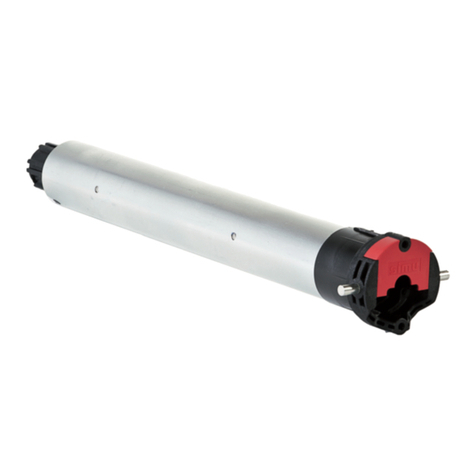
Simu
Simu T5 AUTO SHORT Hz User manual
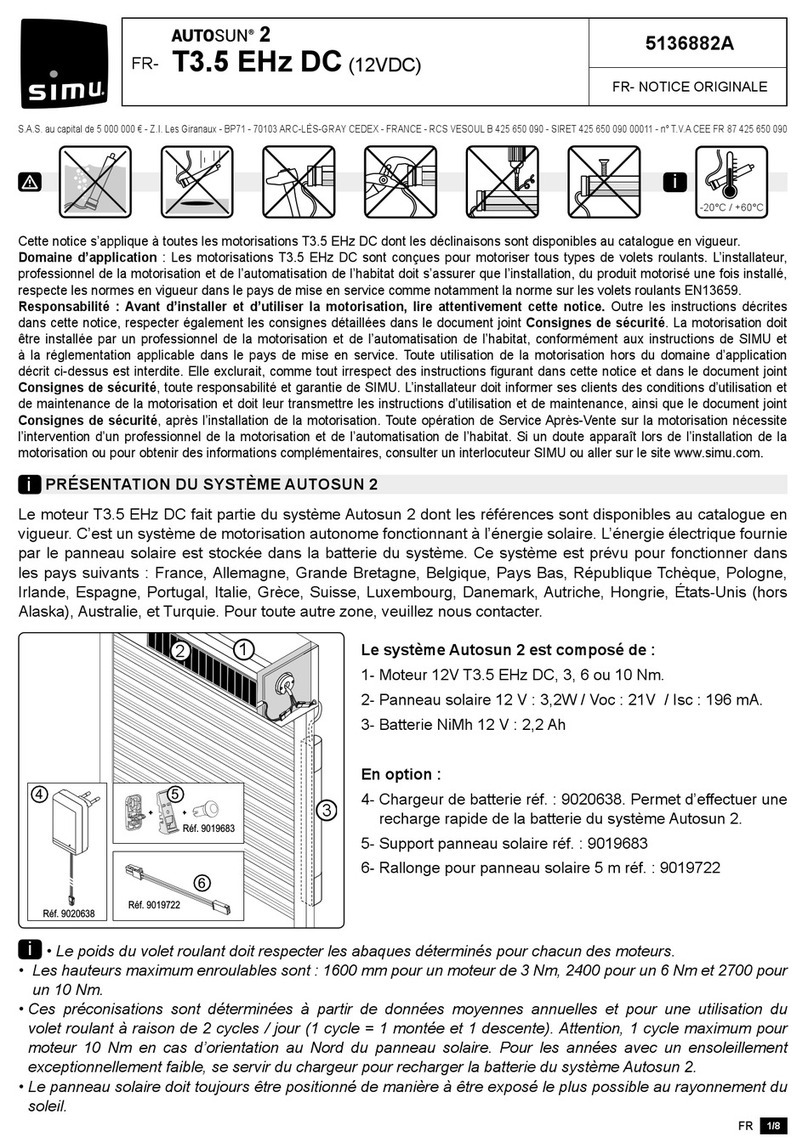
Simu
Simu Autosun 2 T3.5 EHz DC User manual

Simu
Simu T5E-SP Hz User manual
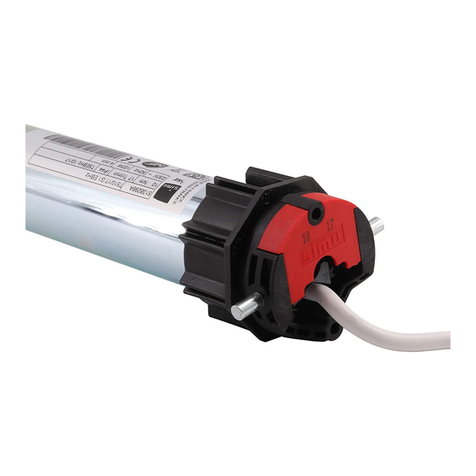
Simu
Simu T3.5EBHz User manual

Simu
Simu T5E-SP User manual
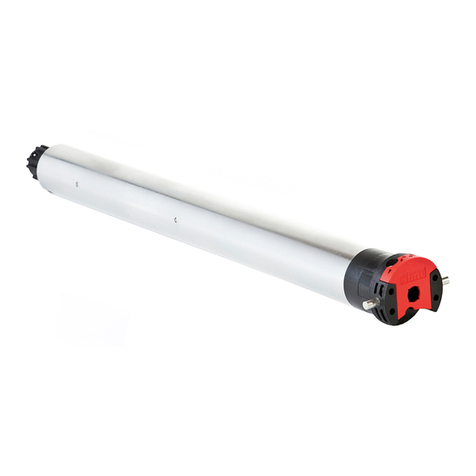
Simu
Simu T3.5EBHz User manual
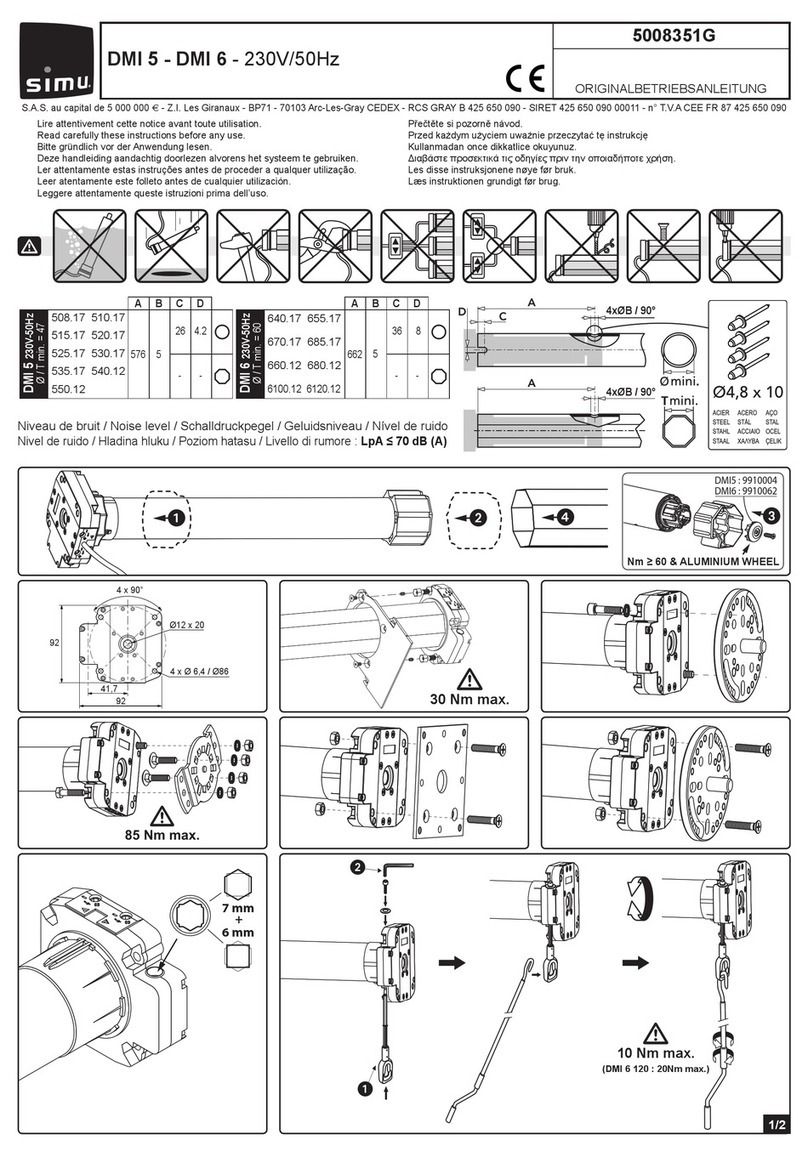
Simu
Simu DMI 6 User manual
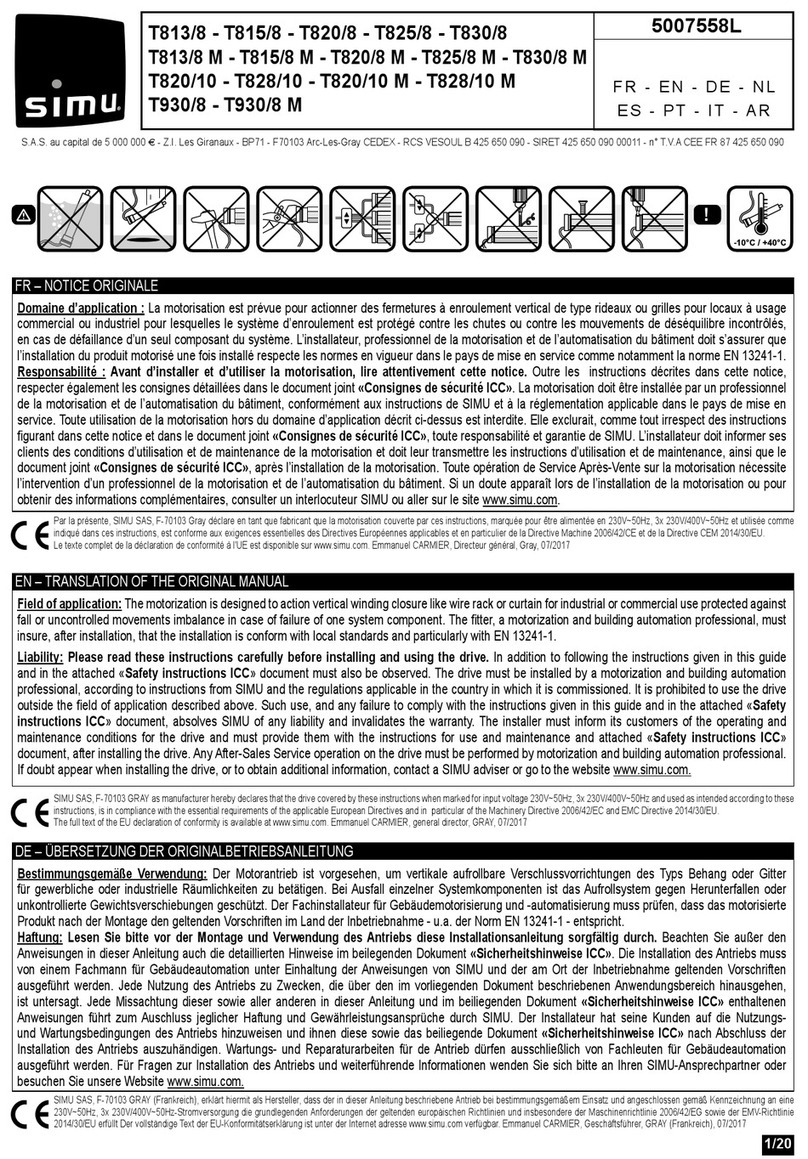
Simu
Simu T813/8 Repair manual
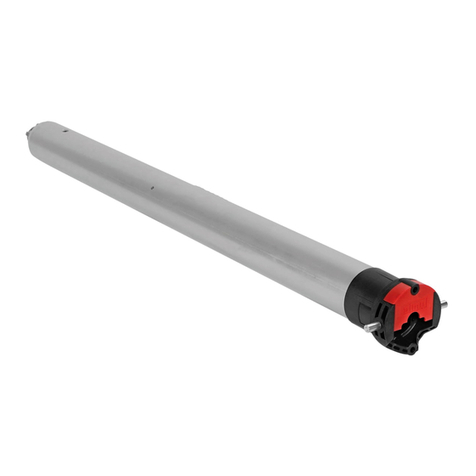
Simu
Simu T5 AUTO+JOB Series User manual

Simu
Simu T845/10 K User manual
